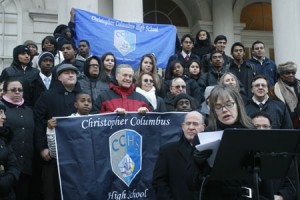When Angel Sosa transferred to Bronx Academy High School in the South Bronx almost a year and a half ago as a sophomore, he only had 10 credits out of the roughly 44 needed to graduate. “I woke up this morning with three acceptance letters to college,” the 18-year-old senior told the city’s Panel for Educational Policy, which on Thursday night voted to close the school.
In March, the Department of Education proposed the phase out of Bronx Academy because of its poor performance and its inability to turn its failing record around quickly. The school received two F’s and a C in its last three report cards.
Students and teachers presented data to demonstrate the changes the school has implemented in the past eight months under the leadership of new Principal Gary Eisinger. According to a 43-page document distributed to the panel, the school saw a 25 percent increase in the number of students who passed the Regents exams, and attendance is up to 73 percent from 67 percent.
Senior Snanice Kittel, 16, told the panel members that her teachers genuinely cared about students and were helping them to succeed. “They will call in the morning to make sure you go to class. And they will even visit your house and talk to your parents if you haven’t come,” she said, explaining that these practices were put in place under the new administration.
Their case was not persuasive enough to convince the panel to vote to save the school.
“We are proud of the work Gary has done in the school,” said Deputy Chancellor Marc Sternberg. “Even if there has been improvement, it’s well below what we expect to see,” he said, adding that the numbers presented by the school staff was inaccurate and that its own assessment revealed a different story.
Frederick R. Coscia, a statistician and economics teacher at Bronx Academy, insisted the Department of Education was basing its decision to close the school on two-year-old data. “We deserve our own report this year,” he said.
Monica Major, the Bronx representative to the panel, requested a postponement of the vote to phase out of the school. The motion was denied.
“We asked for a miracle, we got it and now we will not see the end of it,” said Major as the audience yelled at the panel to “look at the data.” She reminded her colleagues on the panel that Bronx Academy High School is a transfer school that takes students who have already failed in other schools. Opened in 2003, this “transfer school” serves an alternative for overage students who have trouble graduating from a regular high school.
Despite acknowledging the work done by transfer schools and what they represent, the newly appointed Chancellor Dennis Walcott said Bronx Academy “has not done the job.” “We base our decisions on facts and not solely on emotions,” he said, citing the school’s poor performance and its inclusion in the New York State’s “persistent lower achieving” schools list.
“We cannot allow more students to go to a school that is not performing at the standards,” Walcott said.
After four and half hours of testimony and amid chorus of “lies, lies” and “shame on you,” the panel approved the phase-out of Bronx Academy by nine votes to five. Only the five borough representatives opposed the closure. Starting in September, the school will not accept new students and will have until June 2013 to graduate those who are currently enrolled. It will be replaced by Bronx Arena High School, a transfer school that will open its door for the 2011-2012 school year.
English teacher Robert MacVicar expressed his disappointment with the chancellor and the panel for not giving the school a one-year reprieve. “I am saddened by Mr. Walcott’s and Mayor Bloomberg’s failure to take reasonable and compassionate account of our students’ deep and abiding goodness, despite their sometimes soul-trying circumstances at home and on the mean streets of South Bronx,” he said.
Visibly upset, Angel Sosa asked why the panel did not take his testimony and others who spoke into consideration. “I had come with hope,” he said.
As students and supporters of the school left, Principal Eisinger said he appreciated the support he received.
“I put a lot of heart into the school,’’ he said, “and it shows.”







